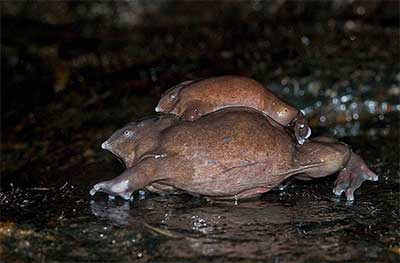Daily-current-affairs
/
09 Nov 2020
Mahabali Frog : Daily Current Affairs

Mahabali Frog
Why in NEWS ?
- The purple frog, one of the rarest frog species endemic to the
Western Ghats, would soon be declared as Kerala’s official
amphibian.
About
- A proposal for declaring the purple frog, also known as pignose
frog, as state’s amphibian, is in the active consideration of the
state government.
- The proposal is in the active consideration of the
government and soon it will be declared as the state’s
amphibian.
- The matter will be discussed in the next meeting of the
state wildlife board.
- Official sources said the move to declare it as the state’s
amphibian as it was mostly endemic to Kerala region of Western
Ghats.
- The purple frog was recommended as a strong candidate for
the state amphibian as it was easy to recognise, resemblance to
King Mahabali visiting above ground for a single day and one of
the most popular frogs in the world.
Mahabali Frog/Purple Frog
- The purple frog, scientifically called Nasikabatrachus
sahyadrensis is listed as endangered in the IUCN Red List of
Threatened Species as its “Extent of Occurrence is less than 5,000
km, all individuals are in fewer than five locations, and there is
continuing decline in the extent and quality of its habitat in the
Cardamom Hills.”
- Mahabali, or Maveli, was a mythological king who ruled over
the region of Kerala. The frog is compared with the Mahabali due
to their similar characteristics that’s why given the name "Mahabali".
- EDGE Fellow at Zoological Society of London, named it as
the “Mahabali frog” as it emerges from under the ground for only
one day, like Kerala’s mythological King Mahabali who was
banished to the underworld and given permission to meet his
subjects in Kerala during Thiruvonam day of Malayalam month of
Chingam.
- The purple frog, is not only a rare frog species but is
also one of the unique amphibians, which remains underground
most of the year, is found mostly in the Kerala part of the
Western Ghats.
- The frog was found in one forest area of Tamil Nadu also.
- Researchers have found that the Purple frog (Nasikabatrachus
sahyadrensis), lives almost its entire life in underground
tunnels, comes out to the surface for a single day in a year to
breed and lays its eggs, and returns to the earth’s deepest
layers.
Appearance
- The purple frog has a bloated body with short stout limbs and
is dark purple to greyish in colour.
- Reaching to about 7 centimetres, it has a small head in
comparison to the body length, and an unusually pointed snout.
- Its short and muscular forelimbs with hard palms help it to
burrow underground.
- Unlike other frogs, it has very short hind legs, which does
not allow it to leap from one spot to another.
- As a result, it covers any distance with long strides. It
depends more on its sense of smell to hunt out soil termites
underground.
Significance
- According to WWF, purple frog has been acknowledged by
bio-geographers all over the world as one of the rarest kinds and a
“once in a century find.”
- It’s a unique species and endemic to this part of the
southern Western Ghats and cannot be found anywhere else.
- Discovered for the first time in 2003 in the jungles of
Kerala, the species sparks feverish imagination among
herpetologists worldwide for a number of reasons:
- They believe that the species should be rightly called a 'living
fossil' as it’s evolutionary roots suggest it could have shared space
with dinosaurs going back almost 70 million years ago.
- It was able to survive such a long period in time, points to its
tenacity and could help scientists understand how it’s population may
have evolved and learned to overcome the challenges of shifting land
masses
- By conserving the Mahabali frog the whole aquatic eco-
system along with the biodiversity of Western Ghats can be
conserved.







